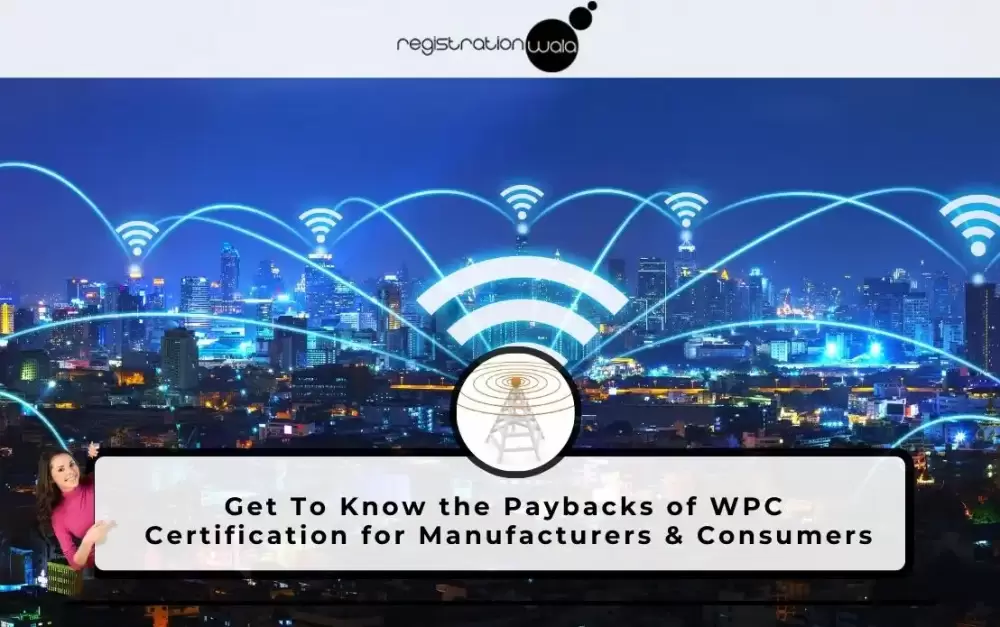Get To Know the Paybacks of WPC Certification for Manufacturers and Consumers
- April 27, 2023
- Registrationwala

- Home
- /
- Knowledge Base
- /
- Telecom
- /
- WPC ETA Certificate
- /
- Get To Know the Paybacks of WPC Certification for Manufacturers and Consumers
Get To Know the Paybacks of WPC Certification for Manufacturers and Consumers
Due to the rapid increase in the adoption of wireless technology by the public, it became necessary for the government of India to setup a governing body overseeing the manufacturing and emission norms. This is where India’s Wireless Planning & Coordination Wing came into action which primarily looks after the legal elements related to wireless technology. Companies involved into the manufacturing and sales of wireless products are obliged to seek the approval of WPC for their wireless products. There are generally two types of wireless frequency bands used in India – accessible and non-accessible. The products coming under these categories are needed to apply for an ETA (Equipment Type Approval) for the corresponding frequency bands that come with zero cost. Similarly, for paid frequency bands, the application must be sent to secure a WPC license. The license holder and the ETA are meant to be registered as a product manufacturer in the local region. For mobile carriers, an application must be made for 2G, 3G, and 4G with respect to CE R & TTE or FCC ID.
Basic Details about WPC Certification or WPC license
- The certification is necessary for wireless equipment manufacturers
- It doesn’t need a site-based inspection
- No sampling is required if RF report for CE is available
- No regional testing required
- May need local agents
- Certification approval timeframe may vary between 3 and 4 weeks
- Certificate is lawful for extended time periods
According to WPC experts, any kind of wireless communication that is done below the frequency of 2000 GHz is called “wireless communication”. WPC has been assigned to the management of these spectral ranges. It also means all types of wireless communication over 3000 GHz can’t be termed “wireless communications.” These frequencies don’t come under the purview of WPC.
Since India has basically two types of free and closed frequency bands, an ETA certification is needed to the applied to the WPC. Moreover, the ETA holders can only be locally registered manufacturers. And, WPC validates the data related to RF through the CE report without requiring testing or samples.
Benefits of WPC Certification for Manufacturers and Consumers
The WPC certification is known to have a number of benefits to manufacturers and consumers. They include:
Legal Agreement: In a country like India, operating wireless devices without a WPC certification is strictly restricted for product manufacturers. Non-compliance to this can lead to sanctions, penalties, and jail time.
Safety: The WPC certification for consumers guarantees that wireless devices used by Indian consumers follow the government's defined safety norms. This guarantees the safety for both the surrounding environment and the user.
Quality: The WPC certification for manufacturers ascertains that the wireless devices manufactured and sold used in India follow stringent technical requirements defined by the government. This also ensures the effectiveness and quality of the devices.
International Roaming: Mobile phones and other wireless equipment are not allowed for usage during international travel without the respective WPC certification. Wireless devices may not work internationally without the required certification.
Different Types of WPC Certification
Given the specific type of wireless device being used and the corresponding frequency range, there are different types of WPC certifications. These WPC certifications are defined below:
Equipment Type Approval (ETA): An ETA refers to a license allotted to a wireless device manufacturer or importer. The license confirms that the device meets the stated technical and security guidelines defined by the government.
An individual or a company using wireless devices in India is obliged get a Wireless using Licence (WOL).
Import Licence (IL): As its name states, an IL is termed a license that is given to a wireless device importer. It conforms to the point that the imported gadget meets the government's specified technical requirements and safety criteria.
How to Get WPC Certificate
The procedure to obtain WPC certification is inclusive of the following steps:
1. Find out the exact type of WPC certification that is needed: First and foremost, determine the certification type required given the type of wireless device and frequency band being used in it.
2. Submit the application: The application for certification is forwarded to the WPC division of the Department of Telecommunications (DoT). Given the type of WPC certification required, the application can be submitted either online or offline.
3. Determine the costs: The cost of certification needs to be deposited by the applicant. Please note that each certification has a different cost.
4. Test the wireless device: To ensure that the wireless device meets technical and safety criteria defined by the government, the device is supposed to be examined in a government-approved testing centre.
5. Approval: Once the device is tested against all the stated parameters, the WPC division of the DoT released the certification to the manufacturer.
Also read: Importance of Dealer Certification in India for Weights and Measures: An Overview
- 2477 views
